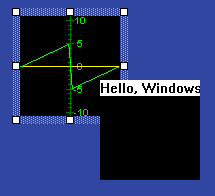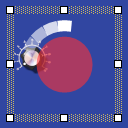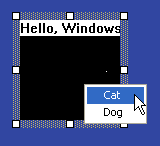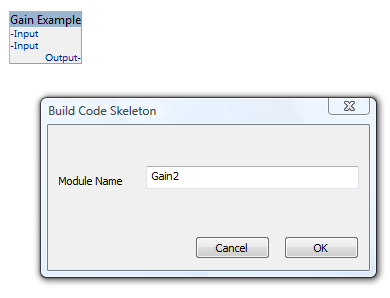 Plugins
Plugins Plugins
Plugins3 Compilers have been tested with the SDK:
http://msdn.microsoft.com/vstudio/
The SDK was written using this compiler.
The Visual C++ Express
version is free, but requires you to download
Windows Platform SDK yourself.
Also cheap for Students is the Academic version. Shop around to get the
best price.
Code::Blocks integrated development environment.
This is good, free, modern compiler. See Using Code::Blocks with SynthEdit tutorial.
This compiler is too old now, it does not work with this SDK.
To help convert your modules to the new SDK, SE includes a simple code generator. On your existing module... Right-click->Build Code Skeleton. This creates the template code for your module in the folder "C:\SE\My Projects\modules_source" - you need to create that folder first.
The template doesn't do any processing, it's just a non-functioning module with the pins and module-name etc. setup for you, to save you typing the boring bits. NOTE - SE SDK3 does not yet support GUI DT_ENUM pins. Avoid upgrading any modules with those.
// Process audio. void Gain::subProcess( int bufferOffset, int sampleFrames ) { // assign pointers to your in/output buffers. Each buffer is an array of float samples. float* in1 = bufferOffset + pinInput1.getBuffer(); float* in2 = bufferOffset + pinInput2.getBuffer(); float* out1 = bufferOffset + pinOutput1.getBuffer(); for( int s = sampleFrames; s > 0; --s ) // sampleFrames = how many samples to process (can vary). repeat (loop) that many times { float input1 = *in1; // get the sample 'POINTED TO' by in1. float input2 = *in2; // Multiplying the two input's samples together. float result = input1 * input2; // store the result in the output buffer. *out1 = result; // increment the pointers (move to next sample in buffers). ++in1; ++in2; ++out1; } }
Like VST, your module processes 'blocks' of audio samples. These samples arrive in an array/buffer. You process around 100 samples during each call to subProcess(). In this example the audio is retrieved via a pointer ( *in1 ), then after each individual sample is processed, we advance the pointer to the next sample (++in1).
Advanced note: If your code needs to change the floating point flags - set the flags at the start of subProcess(), then restore the original flags at the end.
Every module needs some meta-data to describe the module, it's parameters, and it's input and output pins.
SDK3 introduces an easy, compact format based on XML. This example is called "Gain3", it has 2 inputs and one output.
<?xml version="1.0" encoding="utf-8" ?>
<PluginList>
<Plugin id="SynthEdit Gain example V3" name="Gain3" category="SDK Examples" helpUrl="gain.htm">
<Audio>
<Pin id="0" name="Input1" direction="in" datatype="float" rate="audio" default="0.8"
/>
<Pin id="1" name="Input2" direction="in" datatype="float" rate="audio" default="0.8"
/>
<Pin id="2" name="Output" direction="out" datatype="float" rate="audio" />
</Audio>
</Plugin>
</PluginList>
id
name
category
helpUrl
graphicsApi{HWND,composited,none}
polyphonicSource{ true, false }
polyphonicAggregator{ true, false }
cloned{ true, false }
voiceMonitorIgnore{ true, false }
GUI
Parameters
Pins
id
name
datatype {float, int, text, blob, midi, bool, enum (DSP only. not fully supported)}
default
direction {in, out}
rate {audio} - float pins only. Distinguishes streaming audio pins from
event-driven 'control signals' (float pins, int pins etc.).
private{ true, false }
autoRename{ true, false }
isFilename{ true, false }
linearInput{ true, false } SynthEdit can save CPU in some cases by sending two signals through the same module. For example imagine a polyphonic synth with a master volume control at the end of the signal chain. There are two possible topologies: A- One volume control per voice, then sum the voices together. B- Sum the voices, then apply one volume control. Option B uses less CPU. SynthEdit will use this optimisation only if the module input is linear. Hence the 'linearInput' flag. A distortion or clipper module is not linear because summing the voices first results in a louder signal (and more clipping). These types of module can't use the optimisation because the end result is not the same.
ignorePatchChange{ true, false }
autoDuplicate{ true, false }
isMinimised{ true, false }
isPolyphonic{ true, false }
autoConfigureParameter{ true, false } This goes hand in hand with
the RangeMinimum/Maximum settings. Except this flag goes on the Sliders output
pin. It indicates to SynthEdit that when you connect the Slider's output pin,
the slider should be initialised to the destination pin's default value, and the
Minimum and maximum range should be set to suit the destination pin.
parameterId
parameterField{ Value, writeable only in SynthEdit environment -ShortName , MenuItems,MenuSelection,RangeMinimum,RangeMaximum,EnumList,FileExtension
IgnoreProgramChange,Private,Automation,Automation Sysex,Default,Grab,Normalized
}
metadata - For audio pins the format is ",,40,0". When user connects a
slider, the sliders minimum and maximum travel is automatically set. In this
example min=0, max=40. SynthEdit does not enforce these limits, the user can
override them. Only valid on input pins. The first two blank values are
depreciated and ignored.
notes
notes
hostConnect{
PatchCommands, MidiChannelIn, ProgramNamesList, Program, ProgramName,
Voice/Trigger, Voice/Gate, Voice/Pitch, Voice/VelocityKeyOn,
Voice/VelocityKeyOff, Voice/Aftertouch, Voice/VirtualVoiceId, Voice/Active,
VoiceAllocationMode, Bender, HoldPedal, Channel Pressure, Time/BPM,
Time/SongPosition, Time/TransportPlaying }
To save CPU SynthEdit suspends processing on unused voices. This can lead to a problem when the module is 'woken' to play a new note - it's inputs may have changed while the module was suspended. This can be due to the user changing patch, or because an LFO or envelope feeding the module has changed while the module was inactive.
From the module's point of view, it's input has 'spiked' or 'stepped'
suddenly, any kind of filter in this situation will ring for a short time before it settles.
This is quite noticeable in SE synths with resonant filters as a click on the next few note-ons after changing patch.
SE has a specific signal for this situation, called Voice/Active. This is a reset signal that you can use to reset your module to an as-new state...to zero any filter history variables etc. This minimises artefacts.
This reset signal is sent only on new notes when the voice has been suspended. It's NOT used in situations like mono-mode when one note is gliding into the next, because since the voice is not interrupted there's no need to reset any module. This avoids clicks.
This signal is not needed for most modules, it's mostly for modules with feedback, like filters or delays.
You can see it in use in the ADSR2 source code...
<Pin id="8" name="VoiceReset" direction="in" datatype="float" hostConnect="Voice/Active" isPolyphonic="true" />
void Envelope::onSetPins(void) { bool forcedReset = pinVoiceReset.isUpdated() && pinVoiceReset != 0.0f; if( forcedReset ) { // envelope must reset to zero. } }
Communicating values between GUI and DSP is much the same as SDK2, except SDK3
requires less code.
The sender needs an output pin. The
receiver needs an input. A Parameter provides the connection.
[DSP]à[PatchParameter]à[GUI]
An ‘output’ parameter sends from DSP->GUI. An ‘input’ parameter from GUI->DSP.
Example: Send a float from Audio to Graphics class.
Add one audio pin, one GUI pin, and one parameter to you XML:
<Plugin
id="SE PatchMemory Float Out"
name="PatchMemory Float Out3"
category="Sub-Controls" >
<Parameters>
<Audio>
<GUI>
</Plugin>
In you C++ code make the pins
as per usual..(relevant lines only shown)..
Declare the pin as usual.
class PatchMemoryFloatOut:
public MpBase
Initialize it as usual.
PatchMemoryFloatOut::PatchMemoryFloatOut(IMpUnknown* host) : MpBase(host)
Anytime you want to send a
value to the GUI simply assign to the output pin....
pinValueOut = 123.0;
Declare the output float pin.
class PatchMemoryFloatOutGui :
public MpGuiBase
Initialize it in the
constructor. Giving a member function to call when updates arrive.
PatchMemoryFloatOutGui::PatchMemoryFloatOutGui( IMpUnknown* host ) : MpGuiBase(
host )
Your function is called to
notify the GUI each time the DSP sends an updated value.
void
PatchMemoryFloatOutGui::onValueInChanged()
SynthEdit supports two types of windows.

These are the plain regular windows as used in most applications. They are
always rectangular and always obscure any window 'behind' them.
Advantages

Created to support non-rectangular shapes, these are still actually rectangular but support transparent pixels. Here the red circle is partially transparent.
Advantages:
Disadvantages
Specify which type by deriving your from the appropriate base class. In your graphics class header file, and also in your XML file...
For a native window...
MyPluginGui.h
class MyGui : public SeGuiWindowsGfxBase
{
MyPlugin.xml
<Plugin id="SynthEdit Scope3" graphicsApi="HWND">
class MyGui : public SeGuiCompositedGfxBase
{
<Plugin id="SynthEdit Scope3" graphicsApi="Composited">
You can customize SynthEdit's right-click context menu.

In your .h file...
virtual int32_t MP_STDCALL onCreateContextMenu();
virtual int32_t MP_STDCALL onContextMenu( int32_t selection );
In your .cpp file...
// Add custom items to right-click menu.
int32_t MyGui::onCreateContextMenu()
{
getHost()->addContextMenuItem( L"Cat", 0, 0 );
getHost()->addContextMenuItem( L"Dog", 1, 0 );
return gmpi::MP_OK;
}
// act on user selecting right-click item.
int32_t MyGui::onContextMenu( int32_t selection )
{
switch( selection )
{
case 0:
// 'Cat' selected
break;
case 1:
// 'Dog' selected
break;
};
return gmpi::MP_OK;
}
To override SynthEdit's right-click handler. NOTE: If possible please avoid doing this as it disables SynthEdit's pop up menu system.
In your .h file...
// This handles the Windows message loop.
// Add here to override right-click behaviour.
virtual LRESULT MsgProc( HWND hwnd, UINT message, WPARAM wParam, LPARAM lParam );
int32_t onRButtonDown( UINT flags, POINT point );
int32_t onRButtonUp( UINT flags, POINT point );
In your .cpp file...
// Test overriding right-click handling.
// WARNING: This will disable SynthEdit's right-click menu. If possible please avoid taking
// right-click for your own use.
LRESULT MyGui::MsgProc( HWND hwnd, UINT message, WPARAM wParam, LPARAM lParam )
{
switch (message)
{
case (WM_RBUTTONDOWN):
{
POINT p;
p.x = MAKEPOINTS(lParam).x;
p.y = MAKEPOINTS(lParam).y;
onRButtonDown( (UINT) wParam, p );
}
return 1;
break;
case (WM_RBUTTONUP):
{
POINT p;
p.x = MAKEPOINTS(lParam).x;
p.y = MAKEPOINTS(lParam).y;
onRButtonUp( (UINT) wParam, p );
}
return 1;
break;
default:
return SeGuiWindowsGfxBase::MsgProc( hwnd, message, wParam, lParam );
break;
}
}
int32_t MyGui::onRButtonDown( UINT flags, POINT point )
{
return gmpi::MP_OK;
}
int32_t MyGui::onRButtonUp( UINT flags, POINT point )
{
return gmpi::MP_OK;
}
SDK Version 3 is designed to control the host in a very natural way. You put a
special pin on your GUI Module class, and specify what you want to connect it to
(on the host).
Think of the host itself being like a SEM with pins exposed for various features...
For example the keyboard2 module connects to the host's "Voice/Pitch" pin like so...
<Pin id="0" name="Pitch" direction="in" datatype="float" hostConnect="Voice/Pitch" />
- Put an DT_INT pin on your GUI Module.
- specify - hostConnect="PatchCommands".
- Valid commands are:
0 null
1 CopyPatch
2 LoadPatch
3 SavePatch
4 LoadBank
5 SaveBank
To initiate a bank load. Set your pin to 4, then back to zero (ready for the next command). SynthEdit will display the Bank-Load dialog box, then load whatever bank the user selects.
You may need to release an updated version of your module with more features. Your users will have SynthEdit projects created with the older version. Changes to your module can cause those existing projects to crash. There are some guidelines you need to follow when adding or removing pins from an existing module.
RULE 1 - The worst thing you can do is:
Add a new pin using the same ID, but a different type or direction. E.g.
[-input ] ID=0
[ output-] ID=1
Release 2:
[-input ] ID=0
[-input2 ] ID=1
When the user updates the module, then reloads his project, a wire that was
previously going to an output is suddenly going to an input, or a pin of the
wrong type. This is likely to crash. Likewise renumbering the existing pin Ids
will cause serious problems.
RULE 2 - It is OK to add new pins at the end of the list:
Release 1:
[-input ] ID=0
[ output-] ID=1
Release 2:
[-input ] ID=0
[ output-] ID=1 pins. It *looks* like they're deleted, but they are still
[-input2 ] ID=2
The original pins are exactly the same, only the last pin is new. This can't
ever cause weird wiring because the old project didn't have wires to the new
pin.
RULE 3 - You can hide pins. It *looks* like they're deleted, but they are still
there. This gives very good backward compatibility.
Release 1:
[-input ] ID=0
[ output-] ID=1
Release 2:
[-input ] ID=0
[ output-] ID=1 (private="true" or IO_HIDE_PIN. User can't see
this pin).
RULE 4 - If you want to release a module with major changes - consider releasing
it with a updated module ID. id="My Module V2". The user will have to
manually replace the old module, but there is no problem loading old projects.
This is very safe.


You should now be able to re-open SynthEdit and insert your new module. (It is not functional yet because it has an empty sub-process method).
Back in Visual Studio you can inspect the new project files. There are a handful of SDK files, plus the actual module files: Gain.h, Gain.cpp, and Gain.xml.
Open Gain2.cpp, inside is the minimal code for your plugin, including a basic subProcess method.
void Gain2::subProcess( int bufferOffset, int sampleFrames )
{
// get pointers to in/output buffers.
float* input = bufferOffset + pinInput.getBuffer();
float* input2 = bufferOffset + pinInput2.getBuffer();
float* output = bufferOffset + pinOutput.getBuffer();
for( int s = sampleFrames; s > 0; --s )
{
// TODO: Signal processing goes here.
// Increment buffer pointers.
++input;
++input2;
++output;
}
}
Note the name has changed from 'sub_process' to 'subProcess', this is an example of the updated coding conventions. Also the buffer pointers are retrieved differently. Otherwise the method is the same as before.
The TODO is a reminder to copy your signal processing code from your old module...
for( int s = sampleFrames; s > 0; --s )
{
float in1 = *input; // get the sample 'POINTED TO' by in1
float in2 = *input2;
// do the actual processing (multiplying the two input samples together)
float result = in1 * in2;
*output = result; // store the result in the output buffer
// Increment buffer pointers.
++input;
++input2;
++output;
}
In the old SDK you had 2 methods to provide your module name and pin names and properties...
// describe your module
bool Module::getModuleProperties (SEModuleProperties* properties)
{
// describe the plugin, this is the name the end-user will see.
properties->name = "Gain Example";
// return a unique string 32 characters max
properties->id = "SynthEdit Gain Example";
properties->about = "by Jeff M (MS)" ;
return true;
}
// describe the pins (plugs)
bool Module::getPinProperties (long index, SEPinProperties* properties)
{
switch( index )
{
// typical input plug (inputs are listed first)
case 0:
properties->name = "Input";
properties->variable_address = &input1_buffer;
properties->direction = DR_IN;
properties->datatype = DT_FSAMPLE;
properties->default_value = "0";
break;
case 1:
properties->name = "Input";
properties->variable_address = &input2_buffer;
properties->direction = DR_IN;
properties->datatype = DT_FSAMPLE;
properties->default_value = "5";
break;
// typical output plug
case 2:
properties->name = "Output";
properties->variable_address = &output1_buffer;
properties->direction = DR_OUT;
properties->datatype = DT_FSAMPLE;
break;
default:
return false; // host will ask for plugs 0,1,2,3 etc. return false to signal when done
};
return true;
}
These methods are gone. In their place is a simple text file - Gain2.xml.
<?xml version="1.0" encoding="utf-8" ?>
<PluginList>
<Plugin id="My Gain2" name="Gain2" category="MyModules" graphicsApi="HWND" helpUrl="Gain2.htm">
<Audio>
<Pin id="0" name="Input" direction="in" datatype="float" rate="audio"/>
<Pin id="1" name="Input 2" direction="in" datatype="float" rate="audio" default="0.5"/>
<Pin id="2" name="Output" direction="out" datatype="float" rate="audio"/>
</Audio>
</Plugin>
</PluginList>
As you can see this is less typing and easy to edit. It also results in faster compilation, less code generated and smaller SEM files.
This method was called anytime a pin was updated.
void Module::OnPlugStateChange(SEPin *pin)
{
state_type in_stat1 = getPin(PN_INPUT1)->getStatus();
SDK3 replaces OnPlugStateChange() with onSetPins().
void Gain2::onSetPins(void)
{
// Check which pins are updated.
if( pinInput.isStreaming() )
{
}
Rather than check inputs for a status of ST_RUN, you now use the isStreaming() method.
Rather than check non-audio pins for ST_ONE_OFF, you now use the isUpdated() method.
void Gain2::onSetPins(void)
{
// Check which pins are updated.
if( pinInput.isUpdated() && pinInput2.isUpdated() )
{
// They both changed at the same time.
}
The functionality is the same as before, just a more readable syntax.
The only substantial difference is - When two pins are updated at the same time, onSetPins() is called only once (with both pins flagged). It was very difficult before to detect simultaneous updates on two pins, now it's easy.
Likewise, when the audio engine starts SynthEdit flags all your input pins as 'updated' and calls onSetPins() just the once. This results in less function call overhead and faster SEMs.
This has been updated. Search-and-Replace your old code with the new look. Don't forget the '&' (address-of) symbol.
Old.
SET_PROCESS_FUNC(Module::sub_process);
New.
SET_PROCESS(&Gain2::subProcess);
TransmitStatusChange() has been replaced with setStreaming(). Less typing, more readable...
Old
getPin(PN_OUTPUT1)->TransmitStatusChange( SampleClock(), ST_RUN );
New
pinOutput.setStreaming(true);
Old
getPin(PN_OUTPUT1)->TransmitStatusChange( SampleClock(), ST_STATIC );
New
pinOutput.setStreaming(false);
Previously, after checking your input pins were silent, you implemented sleep mode with a special process method to filled the output buffers with silent samples. Once that was done you asked the host to put the module to sleep...
// every module has an output buffer of approx. 100 samples.
// before deactivating module, need to fill that buffer with silence.
// "static_count" is counting out those 100 samples.
void Module::sub_process_static(long buffer_offset, long sampleFrames )
{
sub_process(buffer_offset, sampleFrames);
static_count = static_count - sampleFrames;
if( static_count <= 0 )
{
CallHost(seaudioMasterSleepMode);
}
}
Although this is still necessary. The new SDK does it for you. Your module no longer needs any special code. You don't need to port that code to SDK V3.
If you don't want automatic sleep mode, or need to handle it manually you can disable automatic sleep mode...
setSleep(false);
That was the quick guide to porting to SDK3. Any further questions please post to the SynthEdit SDK group at yahoo.
SEM is an implementation of GMPI (Generalized Music Plugin Interface) with a few extensions for SynthEdit. Some less crucial GMPI features are not supported yet.